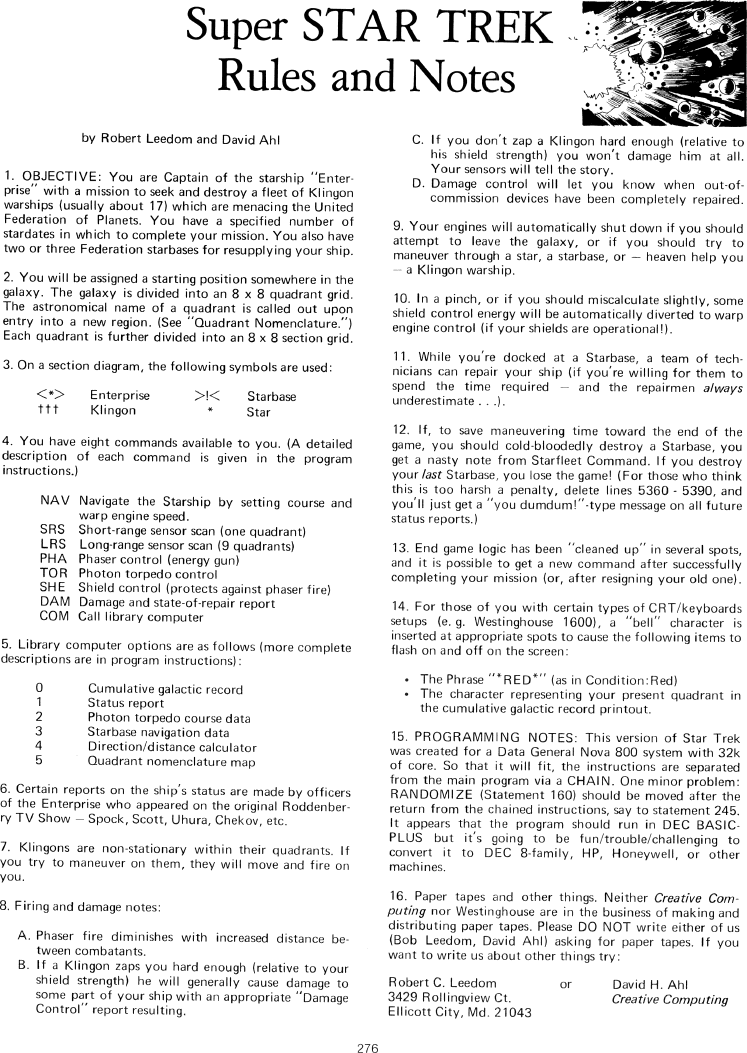The Best of Creative Computing Volume 1 (published 1976)
Super Star Trek (rules and notes)

Super STAR TREK
Rules and Notes
- by Robert Leedom and David Ahl
1. OBJECTIVE: You are Captain of the starship "Enterprise"
with a mission to seek and destroy a fleet of Klingon
warships (usually about 17) which are menacing the United
Federation of Planets. You have a specified number of
stardates in which to complete your mission. You also have
two or three Federation starbases for resupplying your ship.
2. You will be assigned a starting position somewhere in the
galaxy. The galaxy is divided into an 8 x 8 quadrant grid.
The astronomical name of a quadrant is called out upon
entry into a new region. (See "Quadrant Nomenclature.")
Each quadrant is further divided into an 8 x 8 section grid.
3. On a section diagram, the following symbols are used:
<"> Enterprise >!< Starbase
TTT Klingon * Star
4. You have eight commands available to you. (A detailed
description of each command is given in the program
instructions.)
NAV Navigate the Starship by setting course and
warp engine speed.
SRS Short-range sensor scan (9 quadrants)
LRS Long-range sensor scan (9 quadrants)
PHA Phase control (energy gun)
TOR Photon torpedo control
SHE Shield control (protects against phaser fire)
DAM Damage and state-of-repair report
COM Call library computer
5. Library computer options are as follows (more complete
descriptions are in program instructions):
0 Cumulative galactic record
1 Status report
2 Photon torpedo course data
3 Starbase navigation data
4 Direction/distance calculator
5 Quadrant nomenclature map
6. Certain reports on the ship's status are made by officers
of the Enterprise who appeared on the original
Roddenberry TV Show - Spock, Scott, Uhura, Chekov, etc.
7. Klingons are non-stationary within their quadrants. lf
you try to maneuver on them, they will move and fire on
you.
8. Firing and damage notes:
A. Phaser fire diminishes with increased cassettes distance
between combatants
B. lf a Klingon zaps you hard enough (relative to your
shield strength) he will generally cause damage to
some part of your ship with an appropriate "Damage
Control" report resulting.
C. lf you don't zap a Klingon hard enough (relative to
his shield strength) you won't damage him at all.
Your sensors will tell the story.
D. Damage control will let you know when out-of-commission
devices have been completely repaired.
9. Your engines will automatically shut down if you should
attempt to leave the galaxy, or if you should try to
maneuver through a star, a starbase, or - heaven help you
– a Klingon warship.
10. In a pinch, or if you should miscalculate slightly, some
shield control energy will be automatically diverted to warp
engine control (if your shields are operational!).
11. While you're docked at a Starbase, a team of technicians
can repair your ship (if you're willing for them to
spend the time required - and the repairmen always
underestimate. . .).
12. lf, to save maneuvering time toward the end of the
game, you should cold-bloodedly destroy a Starbase, you
get a nasty note from Starfleet Command. lf you destroy
your last Starbase, you lose the game! (For those who think
this is too harsh a penalty, delete lines 5360 - 5390, and
you'Il just get a "you dumdum!" -type message on all future
status reports.)
13. End game logic has been "cleaned up" in several spots,
and it is possible to get a new command after successfully
completing your mission (or, after resigning your old one).
14. For those of you with certain types of CRT/keyboards
setups (e. g. Westinghouse 1600), a "bell" character is
inserted at appropriate spots to cause the following items to
flash on and off on the screen:
• The Phrase "*RED*" (as in Condition:Red)
• The character representing your present quadrant in
the cumulative galactic record printout.
15. PROGRAMMING NOTES: This version of Star Trek
was created for a Data General Nova 800 system with 32k
of core. So that it will fit, the instructions are separated
from the main program via a CHAIN. One minor problem:
RANDOMIZE (Statement 160) should be moved after the
return from the chained instructions, say to statement 245.
It appears that the program should run in DEC BASICPLUS
but it's going to be fun/trouble/challenging to
convert it to DEC 8-family, HP, Honeywell, or other
machines.
16. Paper tapes and other things. Neither Creative Computing
nor Westinghouse are in the business of making and
distributing paper tapes. Please DO NOT write either of us
(Bob Leedom, David Ahl) asking for paper tapes. lf you
want to write us about other things try:
Robert C. Leedom or David H. Ahl
3429 Rollingview Ct. Creative Computing
Ellicott City, Md. 21043


